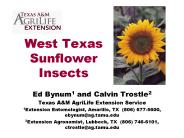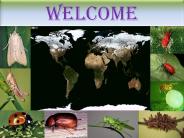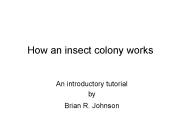Insect Physiology PowerPoint PPT Presentations
All Time
Recommended
Insect physiology ...
| PowerPoint PPT presentation | free to view
INSECT ANATOMY AND PHYSIOLOGY GENERALIZED INTERNAL ANATOMY INSECT STRUCTURE AND FUNCTION INSECT INTERNAL ANATOMY Heart and Dorsal Aorta Ventral Nerve Chord Spiracles ...
| PowerPoint PPT presentation | free to view
Any change in environmental conditions which adversely alters ... Leaf shedding/deciduous habit. Specialised root systems. Altered photosynthetic mechanisms ...
| PowerPoint PPT presentation | free to view
Beth Mitcham Postharvest Physiology and Insect Control ... Sensory Evaluation. Optimizing. Maturity. Dept. of. Plant. Sciences. Fuji Apples. days after bloom ...
| PowerPoint PPT presentation | free to view
Communication Pheromones - chemicals released by an animal that affects the behavior or development of other animals of the same species Sounds Tapping, rubbing, or ...
| PowerPoint PPT presentation | free to view
Plant Physiology by Lincoln Taiz and Eduardo Zeiger
| PowerPoint PPT presentation | free to view
TYPES OF ROOTS. 1. Large Perennial Roots. 2. Fine Roots (Smaller, Ephemeral) ... Male & female flowers on same tree (monoecious) Wind pollination ...
| PowerPoint PPT presentation | free to view
Plant Physiology Essential Standard 3.00: Summarize Plant Anatomy Objective 3.01 Discuss biological terms used to describe plants. Plant Sciences Biology-the branch ...
| PowerPoint PPT presentation | free to view
Plant Physiology Forum. Co-ordinators: Phillip Joy. Kathy Pickle. Insect-Induced Conifer Defense. ... Bark invading insects are major economic and ecological concerns ...
| PowerPoint PPT presentation | free to view
Pest control Important ... Solar Energy to and from the Earth Solar Energy Warms atmosphere Recycles water Generates winds Supports plant growth Greenhouse gases ...
| PowerPoint PPT presentation | free to view
Viruses cannot survive long in vectors. Very infectious right after infected ... through epithelial cells and basal lamina. line mid gut = mid gut barrier ...
| PowerPoint PPT presentation | free to view
Insect s Success Three types of variations: ... Nutrition What do insects eat? A. Predation - hunting/killing other organisms. 99% of all prey is eaten alive.
| PowerPoint PPT presentation | free to download
Gas transport in organisms - a combination of convection and diffusion ... Butt. Anterior Air Sacs. Posterior Air Sacs. 1 bronchus. Mesobronchus. Parabronchi ...
| PowerPoint PPT presentation | free to download
Migration is a complex syndrome of traits; involves many physiological changes. ... Western Sandpipers migrate from Canada to Panama. Also require increases in FABP ...
| PowerPoint PPT presentation | free to download
Anatomy and Physiology- Unit D External Features and Bones Competency: 9.00 Summarize the major parts of small animals Objective 9.01 Describe the major external ...
| PowerPoint PPT presentation | free to view
Plant Anatomy & Physiology By: Johnny M. Jessup Agricultural Instructor/FFA Advisor The Four Basic Parts of Plants Leaves Stems Roots Flowers Leaves Functions Make ...
| PowerPoint PPT presentation | free to view
Physiology, Homeostasis, and Temperature Regulation 29
| PowerPoint PPT presentation | free to view
Animal Science 434 Reproductive Physiology Lec 5: Embryogenesis of the Pituitary and Sexual Development
| PowerPoint PPT presentation | free to download
Human Physiology Immune System (SL and HL)
| PowerPoint PPT presentation | free to download
Anatomy and Physiology Horticulture 1 Why are plants important? Food Shelter Oxygen Protection Habitat Aesthetics The four major parts of the plant are .
| PowerPoint PPT presentation | free to view
Title: Animal Science 434 Reproductive Physiology Author: John Parrish Last modified by: John Parrish Created Date: 2/5/1998 8:36:34 AM Document presentation format
| PowerPoint PPT presentation | free to download
This article discribes the application of Insect Pheromone. Visit https://www.alfa-chemistry.com/products/insect-pheromone-5.htm for more information.
| PowerPoint PPT presentation | free to download
Title: Table of Contents Author: Wendy Beck Last modified by: sa Created Date: 10/16/2000 7:08:56 PM Document presentation format: On-screen Show Company
| PowerPoint PPT presentation | free to download
West Texas Sunflower Insects Ed Bynum1 and Calvin Trostle2 Texas A&M AgriLife Extension Service 1Extension Entomologist, Amarillo, TX (806) 677-5600, ebynum@ag.tamu.edu
| PowerPoint PPT presentation | free to download
Testes develop. Rete Tubules. Undifferentiated. Sex Chords. Mullerian ... Testes develop. Sertoli cells secrete. anti-mullerian hormone (AMH) AMH causes leydig ...
| PowerPoint PPT presentation | free to download
Nymph = immature, wingless stage of an insect without complete metamorphosis ... Young tadpoles are filter feeders algae & other small plant material ...
| PowerPoint PPT presentation | free to view
Plant Diseases and Insect Pests Disease - any kind of injurious abnormality Physiological (environment) Other living organisms (pathogens) Pathogen - biological agent ...
| PowerPoint PPT presentation | free to download
Title: PHYSIOLOGY CHAPTER 6: SKIN & THE INTEGUMENTARY SYSTEM Author: Vaughan Last modified by: Vaughan Created Date: 9/28/2006 9:11:30 PM Document presentation format
| PowerPoint PPT presentation | free to view
Hemorrhage or fluid loss (burns, vomiting, diarrhea, sepsis) Inadequate blood movement ... Burns. GI Tract: Esophageal varices. Ulcer disease. Gastritis ...
| PowerPoint PPT presentation | free to view
Camels: tolerate 30-40% loss of body weight by dehydration (most other mammals: 10-15 ... Camels. Have a countercurrent exchanger in their nose. reduce ...
| PowerPoint PPT presentation | free to download
Animal Physiology Blood What is blood? Hemolymph vs blood Major Functions of Blood Gas Transport Nutrient Transport Waste Transport Transport Chemical Signals ...
| PowerPoint PPT presentation | free to view
returns condition to set point. positive feedback. amplifies activity ... ratio of physiological rate at one temperature to the rate at 10 C lower temperature ...
| PowerPoint PPT presentation | free to view
Design in black and white, adding color for emphasis. ... Colour depends on interactions between the physics of light radiation and the eye-brain system ...
| PowerPoint PPT presentation | free to view
... milk, tears, nasal fluid, gastric juice, intestinal juice, bile, and urine ... destroy it, it also learns to attack human cells that normally bear that protein. ...
| PowerPoint PPT presentation | free to view
About Pheromones
| PowerPoint PPT presentation | free to view
effect of climate change on insect pest population and future challenges ..............
| PowerPoint PPT presentation | free to download
PHYSIOLOGY CHAPTER 5: SKIN & THE INTEGUMENTARY SYSTEM 4 TYPES OF MEMBRANES 1) serous membranes: line body cavities that don t open to the outside location: thorax ...
| PowerPoint PPT presentation | free to view
moves hemolymph forward via dorsal aorta. accessory pulsatory pumps ... silverfish/springtails. stages = egg juveniles adult. SubP. Uniramia: C. Insecta ...
| PowerPoint PPT presentation | free to view
Biology 2672a: Comparative Animal Physiology Kidneys and tubules * * * * * * * * * * * * * * * * * * * * * * * * * * * * * * * * * Kidneys Regulation of salts and ...
| PowerPoint PPT presentation | free to download
applied aspects of respiratory system with special reference to swine flu
| PowerPoint PPT presentation | free to download
Physiology, Homeostasis, and Temperature Regulation Homeostasis: Maintaining the Internal Environment Homeostasis is the maintenance of constant conditions in the ...
| PowerPoint PPT presentation | free to view
Mosquito indirect development. Standing Water. Striders water tension. Divers lower O2 ... Mosquito. Ebony Jewelwing. Hovering Dronefly ...
| PowerPoint PPT presentation | free to view
Topic 6: Human Physiology Fighting the Enemy Within! phagocytic leukocyte Topic 6.3 Defense against the infectious disease lymphocytes attacking cancer cell
| PowerPoint PPT presentation | free to download
Foliage and Houseplant Insect Identification
| PowerPoint PPT presentation | free to view
Migration begins by the 4 week of gestation in cow and human. Germ ... Efferent Ducts (Vas Efferentia) Epididymis. Testis Determining Factor (SRY gene product) ...
| PowerPoint PPT presentation | free to download
... with their own waggle dance language of buzzes and runs (shown on the right) ... These signals are usually based on shaking movements and buzzing sounds. ...
| PowerPoint PPT presentation | free to download
Frog Anatomy and Physiology. The External Parts of a Frog. Head. Front Legs. Fingers. Palm ... Hind Legs. Thigh. Knee. Ankle. Sole. Webbing. Toes. Wildlife ...
| PowerPoint PPT presentation | free to view
Biology 2672a: Comparative Animal Physiology Circulation * * * * * * * * * * * * * * * * * * * * * * * * * * * * * Why have a circulatory system?
| PowerPoint PPT presentation | free to download
Hymenoptera (wasps, bees, and ants). Eusociality evolved several times in ... Coleoptera (beetles), Hymenoptera (ants, bees, wasps, and sawflies), Lepidoptera ...
| PowerPoint PPT presentation | free to view
2. Specific transport (membrane protein) ... Transporter - relatively high specificity ... 2.A Transporters or carriers (uniporters, symporters and antiporters) ...
| PowerPoint PPT presentation | free to view
If in doubt, sit the exam then see the Dr. The Final Exam. 73 Questions. Covers everything from Lecture 2 (Krogh Principle etc) to Lecture 24 (Diving mammals) ...
| PowerPoint PPT presentation | free to download
Biology 272a: Comparative Animal Physiology Animal Navigation * * * * * Demonstrates that adults have an acquired map sense that they use to modify their migration ...
| PowerPoint PPT presentation | free to download
Bats range in body size from as small as 1-in long to as large as 16-in long. ... that makes their wings that is attached to one side of there body and hind leg. ...
| PowerPoint PPT presentation | free to view
Narrative dreaming. CBF is high to visual cortex, low to inferior frontal cortex (Madsen, 1991) ... Cats, dogs, rodents: 12-15 hours daily. Ruminant herbivores: ...
| PowerPoint PPT presentation | free to view
Fatal familial insomnia is caused by a dual mutation involving a prion gene PrP. ... Fatal familial insomnia: thalamus damage. Reduction of sleep spindles and ...
| PowerPoint PPT presentation | free to view
... respiration but also used in oxidizing organic matter, rocks & gases & in ... oxidize Fe as it would when binding free Fe however it can occur under some ...
| PowerPoint PPT presentation | free to view
























































